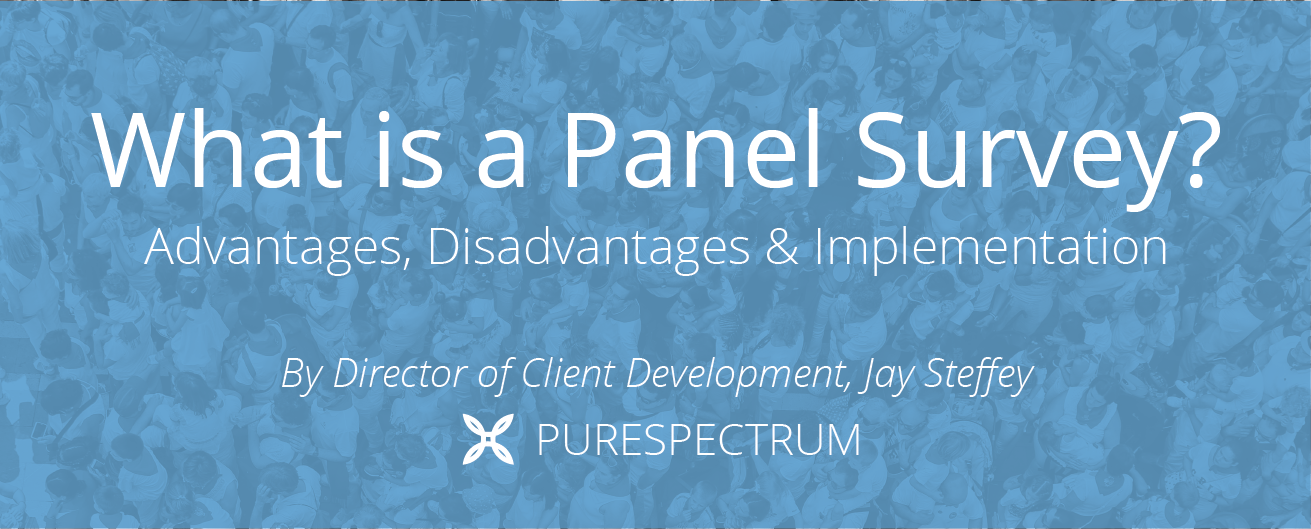
Panel surveys are longitudinal studies that measure consumer opinions, feelings, or thoughts over time. Specific audiences are targeted and studied during separate research waves. Through data set analysis, trends are observed thus leading to a better understanding of changes in consumer behavior.
What are Online Survey Panels?
Online survey panels directly access a pool of respondents to answer survey questions. These participants can come from various sources and are generally interested in answering online surveys for monetary incentives.
Using a grocery store as an example, it may want to see if new offerings suit its customers. To better understand what customers want, the grocery store needs to target individuals who are the primary grocery shoppers in their households. This means their study will need multiple panels to find the correct individuals to interview. Verified survey panels will typically screen, verify and deduplicate respondents to ensure high-quality insights.
The PureSpectrum Marketplace supplies sample worldwide for all types of market research surveys, including but not limited to panel studies. Utilizing multisource technology to expand survey feasibility, the PureSpectrum Marketplace automatically connects any survey to multiple suppliers, allowing clients access to respondents from around the world. Learn more about our sampling practices on our Marketplace Profile.
The Evolution of Panel Survey
Since as far back as Victorian Britain, surveys have collected opinions and informed decisions. In the 1950s, surveys gained further traction with businesses to understand customer perception. Worldwide governmental agencies first used these surveys to measure constituent income, housing, and job experience (National Longitudinal Surveys of Labor Market Experience).
With the rise of the internet and significant shifts in online culture, longitudinal surveys have taken on a whole new meaning and purpose. Businesses now have access to millions of global participants, and researchers can now sample any audience quickly, usually for a low cost. Decision-makers today turn to panel studies to identify advertising efficiency, brand recognition, product success, purchasing behavior, and much more.
How Do Panel Surveys Work?
A panel study is performed through a sequence of interviews, most commonly conducted as online quantitative market research. Researchers ask the same group of people questions and collect data from a series of interviews. All of this information is collected to become a project’s data set.
The sample size and consistency are the most important part of validating panel surveys. Surveying the same demography of people is the most accurate way to record changes in behavior in the responses.
How to Design a Panel Survey
Looking to create a survey but don’t know where to start? Here’s a basic rundown on how the setup process should work:
- Define the purpose of study – What are you trying to achieve or understand by launching this survey?
- Define your quotas – Identify your target audience for the study. Then you will need to stipulate the targeted number of interviews or completes that must be obtained in each wave of your study.
- Define your questions – Work with your team to develop questions that not only survey opinions around your purpose of the study but also help define your target audience even further. If you need help creating a survey, check out our article, Creating a Survey – Tips, Best Practices & Helpful Guidelines.
- Program your survey – If you don’t have someone on your team who can program the study, the PureSpectrum services team is available to help.
- Test – Utilizing a test link, run through your survey to make sure that all logic and programming are working correctly.
- Launch 1st wave – It’s time to start fielding your study.
What are Study Quotas and How Do I Define Them?
Wondering how to better define quotas or sample segmentation in your study? Let’s again use the grocery company as an example. Let’s say the store wishes to sample women ages 18-45 in the United States who are the primary grocery shoppers for their households. They want to know if they should pursue the development of an online order and pickup service. Their market research team has a questionnaire for a consumer panel to measure current purchasing habits, brand preferences, and customer satisfaction. They may break up this longitudinal study into various categories:
Age Groups:
- 18-24
- 25-36
- 37-45
US Region Groups:
- Northeast
- Southeast
- Midwest
- Southwest
- West
The final quota groups nested together would look like this:
- Woman, 18-24 Northeast
- Woman, 18-24 Southeast
- Woman, 18-24 Midwest
- Woman, 18-24 Southwest
- Woman, 18-24 West
- Woman, 25-36 Northeast
- Woman, 25-36 Southeast
- Woman, 25-36 Midwest
- Woman, 25-36 Southwest
- Woman, 25-36 West
- Woman, 37-45 Northeast
- Woman, 37-45 Southeast
- Woman, 37-45 Midwest
- Woman, 37-45 Southwest
- Woman, 37-45 West
As time progresses, the grocery store will want to assess its market research to see if behaviors/opinions on grocery shopping have changed. They will then ask this sample panel a similar, if not identical, questionnaire about their attitudes towards grocery shopping.
Researchers will next analyze the dataset and create reports examining significant differences between the two studies to conclude the success of that particular campaign. Analyses of such survey data will dictate necessary changes to ensure future campaigns see more significant results.
For more information on setting up nested quotas for fielding and how to set them up, visit our Quota Nesting blog article.
Is a Panel Study Right for Your Market Research?
How long is your data collection period? How quickly do you need to analyze results and make a decision? Longitudinal survey methods aim to improve analytic potential by collecting data long-term instead of in a one-time study. This process yields better data for testing and provides visibility into casual relationships and changes in consumer behavior.
Finding out if a panel survey is suitable for the insights you are looking for has to be handled on a case-by-case basis. If you want to gather comparative market research that looks at long-term changes in behavior, a panel study might be worth investigating for your work. Our team is happy to collaborate with you and explore options for your next project.
Advantages of Panel Studies
Longitudinal panel research allows for the collection of large amounts of information. This type of data collection has many advantages:
- Understand trends in real-time: By repeatedly asking the same questions in different waves, a researcher can easily track the difference in respondent answers over time. They can study cultural shifts against different demographics like social media trends and world events as they are occurring.
- Higher quality data: Make better business decisions with longitudinal studies. A survey that allows researchers to ask questions in different waves to the same group of participants often yields higher quality data sets. Because of their predisposition to larger data sets, longitudinal studies are best used for targeted questions that don’t require detailed responses.
- Cost-efficient: Consumers with the same demographics are interviewed rather than recontacting the sample group for each study which is an easier way to field. Panel survey sampling methodology repeats in a longitudinal format over time rather than devoting resources to creating and redesigning the studies for each research wave saving your study money and time.
Benefits of Using an Online Panel Company
When sampling for longitudinal panel studies, there are definite benefits to using an online sample marketplace to source survey respondents.
- Audiences can be specifically targeted to ensure that only the right people enter the proper panel surveys.
- Because panels capture demographic information about all of their participants, researchers can dig deeper and access further details about the people they are interviewing.
- With access to millions of people, utilizing a panel can speed up your sampling time with greater feasibility and shorten your time to insights.
- When working with a verified panel, you can ensure they consider the caliber of respondents.
Items to Consider when Using an Online Panel
Panels are a great way to access millions of people and gather opinions from around the world, but here are some considerations that could cause research biases:
- Panelists are incentivized through points that convert to cash, gift cards, or other rewards. The types/amounts depend on the length of the survey or the specificity it takes to qualify. Respondents are less likely to start, continue or take surveys they feel are offering a low incentive in exchange for their time.
- Panelists can only access surveys online, meaning that only respondents who have access to the internet freely can answer surveys. According to DataSpring, 95.1% of the population of South Korea has access to the internet as opposed to Myanmar, where only 33.1% of the population is online. This can lead to skewed responses and limited access to certain demographics researchers may be interested in interviewing.
Field a Panel Survey with PureSpectrum
When considering a panel survey for your research, consider what you plan on measuring and how. Panel surveys are the best fit for measuring the change in population behaviors and attitudes over time. It can help identify how public opinion shifts depending on current climates, ad effectiveness, trends, and more.
Partnering with a panel company allows you to expand your reach to interview the exact people you need. Working with a sample marketplace can further increase feasibility by automatically connecting you to multiple supply sources.
Want to learn more about launching panel surveys with PureSpectrum? Reach out to our team below:

Jay is an industry veteran and has been in the Market Research space for over 10 years, working with technology and full-service insight and data collection companies. He has specialized in working with agencies and universities to use technology to help streamline the survey process, maximize efficiency and optimize their budget. He is currently the Vice President of Client Development for PureSpectrum based out of New York City supporting the company’s clients in the Eastern region.
